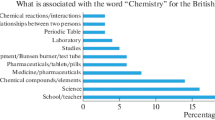Abstract
The global chemical industry has a rich history of investment in campaigns to educate the public about what it does. Beginning in the 1930s, first Dupont then the industry overall promised “Better Living Through Chemistry.” In the 1990s, the industry promoted its own environmentalism. The 2005 launch of the American Chemistry Council’s essential2life campaign was yet another update. This essay examines the shifting logics of chemical industry public education campaigns, focusing particularly on the disavowals of the essential2life campaign. The essay also raises questions about forms of collective deliberation—among scientists, among activists and within industry—that reduce vulnerability to what Kirsch and Benson call “corporate oxymorons,” facilitating critical awareness of ways vested interests shape articulations of history and knowledge.



Similar content being viewed by others
Notes
“Better Living Through Chemistry” originated in a Dupont ad campaign from the 1930s, but then became widely associated with the chemical industry overall. Dupont’s heritage website describes the evolution of Dupont’s public relations strategy: “In 1935 DuPont hired Batten, Barton, Durstine & Osborn (BBD&O) to change DuPont’s image from “the powder people” to “peace time manufacturer.” A corporate advertising campaign was launched promoting DuPont’s role in improving daily life with the slogan “Better things for better living… through chemistry.” The tag line “through chemistry” was removed from advertising in the 1980s. The slogan was replaced in 1999 with “the miracles of science,” capitalizing on DuPont’s heritage and strength as a science company (Dupont 2008).
In 2006, ACC industry successfully lobbied for contraction of TRI reporting requirements, for example. The “rollback” was very controversial. Previous TRI reporting requirements were restored in late spring 2009 and the EPA seems to have re-invested in the TRI. See OMB Watch coverage at http://www.ombwatch.org/node/9781 and http://www.ombwatch.org/node/9761. ACC’s response to the 2006 rollback is here: http://www.americanchemistry.com/s_acc/sec_news_article.asp?SID=1&DID=4467&CID=206&VID=142&RTID=0&CIDQS=&Taxonomy=&specialSearch=.
Researchers and practitioners who focus on human adaptation to climate change also speak in terms of vulnerability and resilience. “Vulnerability” is the term used to describe what puts particular social groups at risk, increasing the likelihood of disaster, and decreasing the capacity to respond to and survive disaster. “Resilience” is the opposing term, and is created by social, cultural, political economic and technical infrastructures that reduce the risk of disaster, and enable people to deal relative effectively with crisis events. How these concepts come to be defined in the coming years will dramatically shape policy and life chances. See, for example, articles by Adger (2006), Folke (2006), and Gallopin (2006) in a special issue of Global Environmental Change.
See http://www.chemicalindustryarchives.org. I develop arguments about the safeguarding effect of (environmental risk) information density and right-to-know legislation in a recent essay, “Environmental right-to-know and the transmutation of law” (Fortun 2009) and also in “From Bhopal to the informating of environmental health: Risk communication in historical perspective” (Fortun 2004).
In “Fetishism,” Freud (1927) stresses the methodological implications of recognizing the difference between repression and disavowal, arguing that repression displaces an affect (but does not eliminate it), while disavowal erases perception (while not eliminating it).
References
Adger, W.N. 2006. Vulnerability. Global Environmental Change 16: 268–281.
Ackerman, Frank. 2008. Poisoned for pennies: The economics of toxics and precaution. Washington, DC: Island Press.
American Chemistry Council. 2005. “American Chemistry Council Unveils New Public Education Campaign; American Chemistry Council Highlights How Chemistry is essential2life,” Press release on Business Wire (September 22).
Centers for Disease Control and Prevention. 2001, 2003, 2005. National Report on Human Exposure to Environmental Chemicals. http://www.cdc.gov/exposurereport/. Accessed 1 June 2009.
Dupont Heritage Website. 2008. http://heritage.dupont.com/touchpoints/tp_1939/overview.shtml. Accessed 15 Nov 2008.
Folke, Carl. 2006. Resilience: The emergence of a perspective for social-ecological analyses. Global Environmental Change 16: 253–267.
Fortun, Kim. 2001. Advocacy after Bhopal: Environmentalism, disaster, new global orders. Chicago: University of Chicago Press.
Fortun, Kim. 2004. From Bhopal to the informating of environmental health: Risk communication in historical perspective, OSIRIS (Special issue: Landscapes of exposure: Knowledge and illness in modern environments, eds. Gregg Mitman, Michelle Murphy and Christopher Sellers) 19: xx–xx.
Fortun, Kim. 2009. Environmental right-to-know and the transmutations of law. In Catastrophe: Law, politics, the humanitarian impulse, ed. Austin Sarat and Javier Lezaun. Amherst: University of Massachusetts Press.
Freud, Sigmund. 1927. Fetishism. Standard Edition, vol. 21, ed. James Strachey et al. 147–157, London: The Hogart Press and the Institute of Psychoanalysis.
Gallopin, Gilberto. 2006. Linkages between vulnerability, resilience and adaptive capacity. Global Environmental Change 16: 293–303.
Merton, Robert. 1942. The normative structure of science. In The sociology of science: Theoretical and empirical investigations, ed. R.K. Merton. Chicago, IL: University of Chicago Press.
Reisch, Marc S. 2009. Chemtura’s bankruptcy. Chemical and Engineering News. 87/12 (March 23), p. 11.
Author information
Authors and Affiliations
Corresponding author
Rights and permissions
About this article
Cite this article
Fortun, K. essential2life. Dialect Anthropol 34, 77–86 (2010). https://doi.org/10.1007/s10624-009-9123-8
Received:
Accepted:
Published:
Issue Date:
DOI: https://doi.org/10.1007/s10624-009-9123-8




